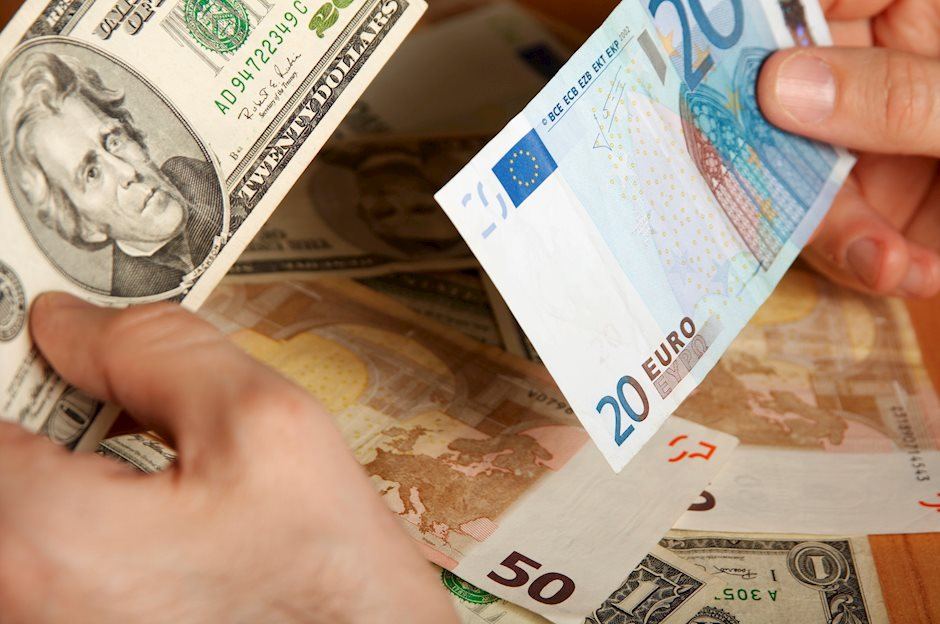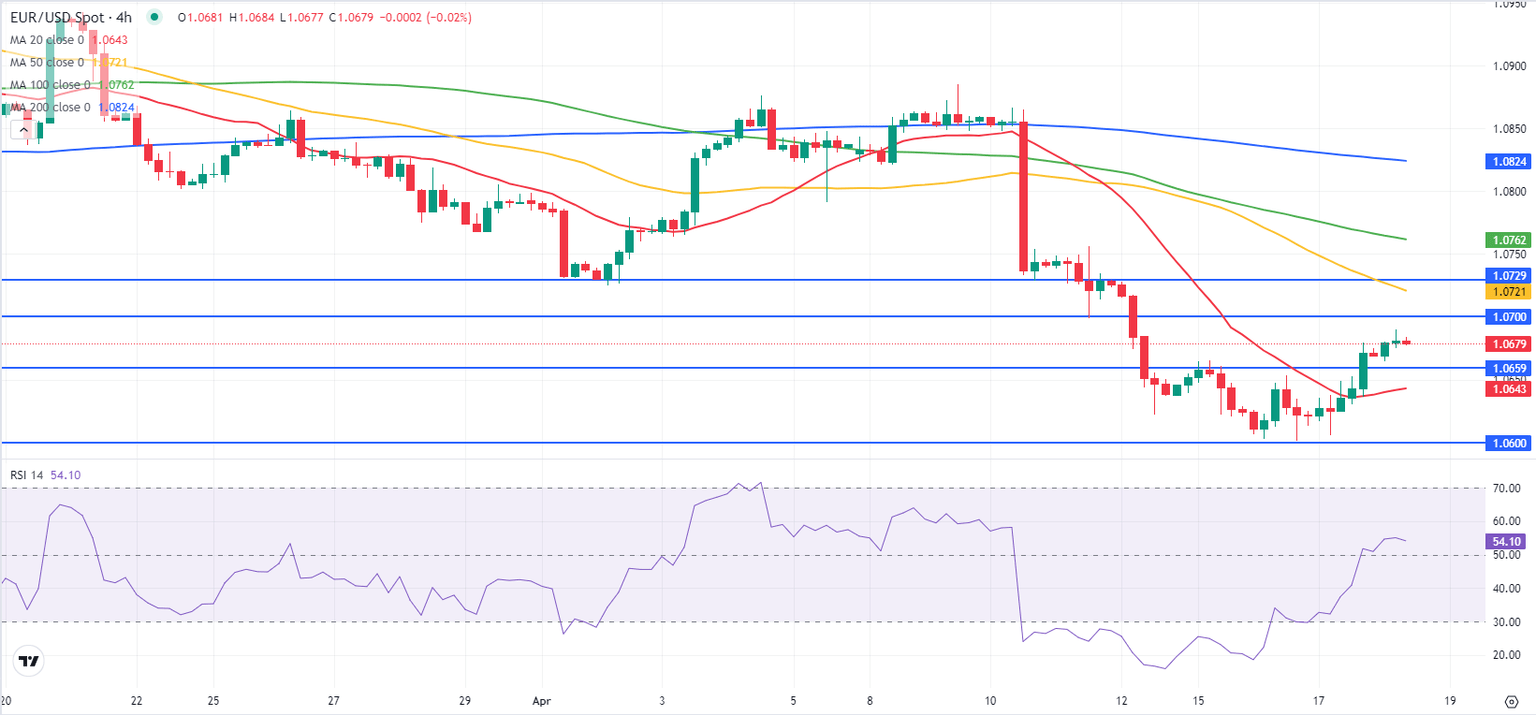EUR/USD Forecast: Euro looks to extend recovery beyond 1.0700
- EUR/USD rises toward 1.0700 after closing in positive territory on Wednesday.
- Near-term technical outlook points to a buildup of recovery momentum.
- The risk-positive market environment could help the pair push higher.

EUR/USD gained traction and closed in positive territory on Wednesday, snapping a six-day losing streak. The pair continues to inch higher toward 1.0700 in the European session on Thursday and the near-term technical outlook highlights a buildup of recovery momentum.
The renewed US Dollar (USD) weakness helped EUR/USD stage a decisive rebound midweek. In the absence of high-tier data releases, retreating US Treasury bond yields weighed on the USD.
Euro price today
The table below shows the percentage change of Euro (EUR) against listed major currencies today. Euro was the strongest against the US Dollar.
| USD | EUR | GBP | CAD | AUD | JPY | NZD | CHF | |
| USD | -0.17% | -0.20% | -0.14% | -0.18% | -0.09% | -0.30% | -0.19% | |
| EUR | 0.17% | -0.03% | 0.04% | 0.00% | 0.10% | -0.13% | -0.05% | |
| GBP | 0.20% | 0.03% | 0.06% | 0.02% | 0.12% | -0.11% | 0.00% | |
| CAD | 0.15% | -0.02% | -0.05% | -0.03% | 0.06% | -0.16% | -0.06% | |
| AUD | 0.19% | 0.01% | -0.02% | 0.04% | 0.11% | -0.12% | 0.01% | |
| JPY | 0.09% | -0.10% | -0.12% | -0.08% | -0.09% | -0.22% | -0.12% | |
| NZD | 0.30% | 0.13% | 0.11% | 0.16% | 0.13% | 0.23% | 0.11% | |
| CHF | 0.21% | 0.05% | -0.01% | 0.05% | 0.01% | 0.14% | -0.11% |
The heat map shows percentage changes of major currencies against each other. The base currency is picked from the left column, while the quote currency is picked from the top row. For example, if you pick the Euro from the left column and move along the horizontal line to the Japanese Yen, the percentage change displayed in the box will represent EUR (base)/JPY (quote).
Later in the session, the US economic docket will feature weekly Initial Jobless Claims data. Investors expect the number of firs-time applications for unemployment benefits to rise to 215,000 in the week ending April 13 from 211,000. A reading close to 220,000 could put additional weight on the USD's shoulders.
In the meantime, US stock index futures trade in positive territory in the European session. A bullish opening in Wall Street could help EUR/USD preserve its recovery momentum.
Markets remain optimistic about an avoidance of a deepening Iran-Israel conflict, with the UK, the EU and the US looking to widen sanctions against Iran.
EUR/USD Technical Analysis
The Relative Strength Index (RSI) indicator on the 4-hour chart climbed above 50 for the first time in a week and EUR/USD closed the last five 4-hour candles about the 20-period Simple Moving Average (SMA), reflecting a buildup of recovery momentum.
1.0700 (psychological level, static level) aligns as immediate resistance before 1.0720-1.0730 (50-period SMA, static level) and 1.0760 (100-period SMA). On the downside, 1.0660 (static level, former resistance) could be seen as first support ahead of 1.0640 (20-period SMA) and 1.0600 (psychological level, static level).
Euro FAQs
The Euro is the currency for the 20 European Union countries that belong to the Eurozone. It is the second most heavily traded currency in the world behind the US Dollar. In 2022, it accounted for 31% of all foreign exchange transactions, with an average daily turnover of over $2.2 trillion a day. EUR/USD is the most heavily traded currency pair in the world, accounting for an estimated 30% off all transactions, followed by EUR/JPY (4%), EUR/GBP (3%) and EUR/AUD (2%).
The European Central Bank (ECB) in Frankfurt, Germany, is the reserve bank for the Eurozone. The ECB sets interest rates and manages monetary policy. The ECB’s primary mandate is to maintain price stability, which means either controlling inflation or stimulating growth. Its primary tool is the raising or lowering of interest rates. Relatively high interest rates – or the expectation of higher rates – will usually benefit the Euro and vice versa. The ECB Governing Council makes monetary policy decisions at meetings held eight times a year. Decisions are made by heads of the Eurozone national banks and six permanent members, including the President of the ECB, Christine Lagarde.
Eurozone inflation data, measured by the Harmonized Index of Consumer Prices (HICP), is an important econometric for the Euro. If inflation rises more than expected, especially if above the ECB’s 2% target, it obliges the ECB to raise interest rates to bring it back under control. Relatively high interest rates compared to its counterparts will usually benefit the Euro, as it makes the region more attractive as a place for global investors to park their money.
Data releases gauge the health of the economy and can impact on the Euro. Indicators such as GDP, Manufacturing and Services PMIs, employment, and consumer sentiment surveys can all influence the direction of the single currency. A strong economy is good for the Euro. Not only does it attract more foreign investment but it may encourage the ECB to put up interest rates, which will directly strengthen the Euro. Otherwise, if economic data is weak, the Euro is likely to fall. Economic data for the four largest economies in the euro area (Germany, France, Italy and Spain) are especially significant, as they account for 75% of the Eurozone’s economy.
Another significant data release for the Euro is the Trade Balance. This indicator measures the difference between what a country earns from its exports and what it spends on imports over a given period. If a country produces highly sought after exports then its currency will gain in value purely from the extra demand created from foreign buyers seeking to purchase these goods. Therefore, a positive net Trade Balance strengthens a currency and vice versa for a negative balance.
Premium
You have reached your limit of 3 free articles for this month.
Start your subscription and get access to all our original articles.
Author

Eren Sengezer
FXStreet
As an economist at heart, Eren Sengezer specializes in the assessment of the short-term and long-term impacts of macroeconomic data, central bank policies and political developments on financial assets.


















